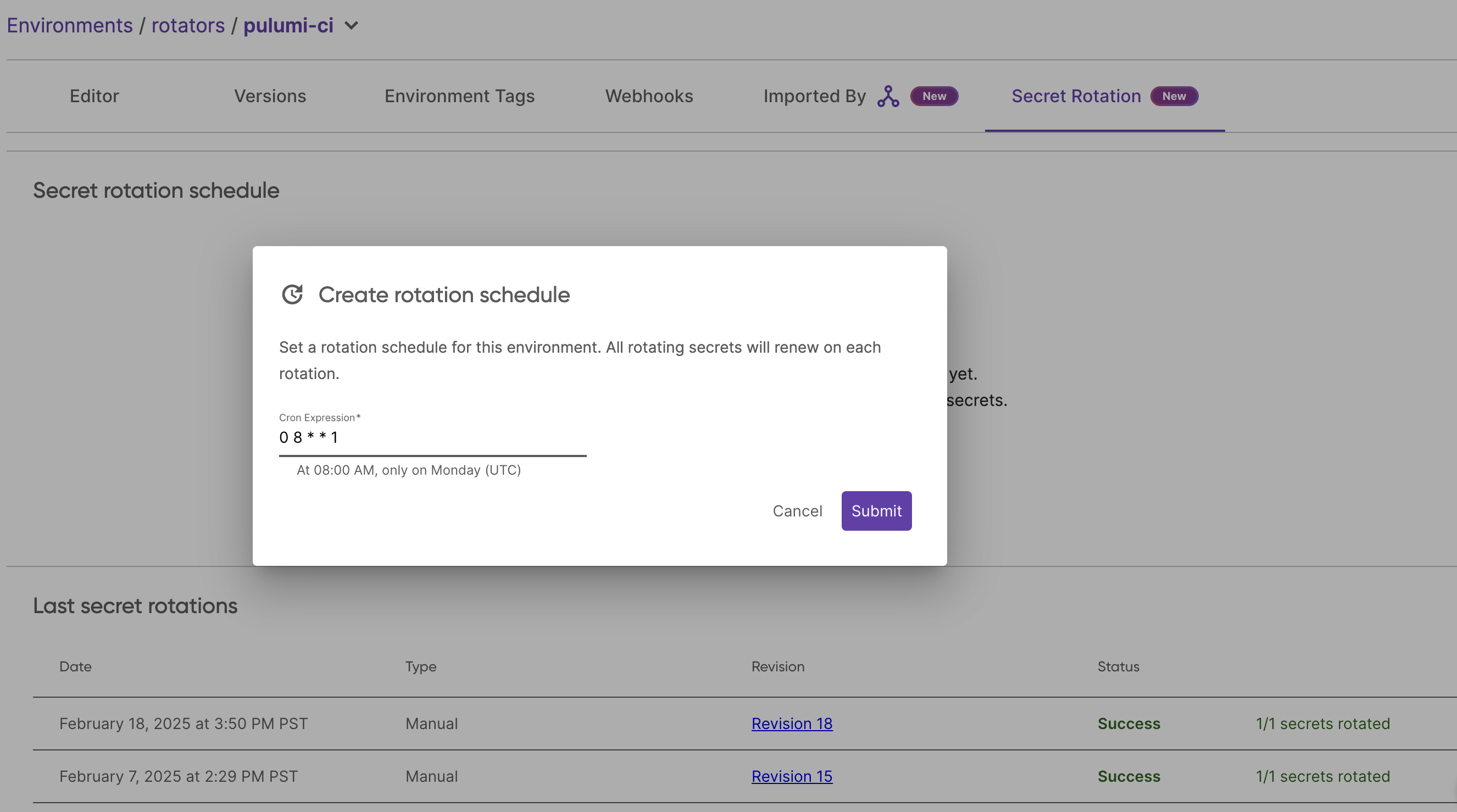Rotating secrets
Secret Rotation is a feature in Pulumi ESC that enables the automated periodic updating of sensitive credentials. By defining a schedule, you can specify when and how often a secret should be rotated, ensuring that any long-lived credentials do not remain static over time. This feature is useful for maintaining best practices in security by reducing the risk of credential exposure or misuse.
ESC Rotated secrets use a two-secret strategy in which two secrets are active and valid at any point in time. This is especially useful when multiple instances of an application share a credential but not all instances pull in the latest credential at the same time, allowing you to rotate a secret without worrying about some instances being unavailable due to invalid credentials.
Usage
Definition
Secret rotations are defined using a special function, fn::rotate::, which is evaluated by the Pulumi ESC runtime during a rotation action, which may be executed manually via the CLI or Pulumi Cloud UI, or automatically on a schedule.
values:
rotatedCredentials:
fn::rotate::aws-iam:
inputs:
region: us-west-2
login: ${environments.credentials.production.aws.login}
userArn: arn:aws:iam::123456789012:user/username
# If there are existing credentials, it's possible to specify them in the state - but this section is optional
state:
previous:
accessKeyId: AKIA...
secretAccessKey:
fn::secret:
ciphertext: ...
current:
accessKeyId: AKIA...
secretAccessKey:
fn::secret:
ciphertext: ...
In the above example, note the ${environments.credentials.production.aws.login} reference. This is an implicit import of the credentials/production environment’s aws.login path.
This import is only resolved at rotate time, meaning that the value is not available during open time, making it possible for a user to access the rotated secret without needing access to the managing credentials.
Rotation
Once a rotation function is configured within the environment definition, you can manually rotate your secrets by running the esc env rotate command, or by clicking the Rotate secrets button in the Pulumi Cloud UI.
Via the CLI
esc env rotate rotators/pulumi-ci
Environment 'rotators/pulumi-ci' rotated.
New revision '19' was created.
Via the Pulumi Cloud UI

Schedule
You can create a schedule for automatic rotation of your secrets in the Pulumi Cloud UI by navigating to the Rotated secrets tab of your environment, and clicking the Create rotation schedule button.
The rotation schedule can be defined as a cron expression.

Rotation Connectors
Many organizations keep their databases in private networks, making it impossible for external credential managers (like ESC) to rotate the credentials.
Pulumi ESC’s solution to that problem are Rotation Connectors - open-source, easy-to-deploy pieces of insfrastructure that will securely rotate your credentials and store them in your ESC Environment for easy use.
See Rotated Secrets page for details on which rotators require you to deploy a rotation connector.
Once you determined that you need one, follow the links below to learn how to set up and use each Rotation Connector.
| Rotation Connector | Description |
|---|---|
| AWS Lambda | The AWS Lambda rotation connector enables you to rotate credentials inside private AWS VPCs. |
Permissions
- To
rotatean environment, a user must haveWRITEpermissions on the environment, andOPENpermissions on any imported environment. - To
openan environment, a user must haveOPENpermissions on the environment (and does not need any permissions for the implicitly imported environment which provides the rotation credentials). - To configure a rotation schedule for an environment, the user must have
WRITEpermissions on the environment.
Best practices
Least privilege
It is recommended to follow the principle of least privilege when defining the permissions for the user or role that will be used to rotate the secret. The user or role should have only the necessary permissions to perform the rotation action, and no more.
The minimum required permissions for each rotation function are documented in the Rotated Secret provider documentation.
Separation of concerns
It is recommended that the login credentials required to perform the rotation action are stored in a separate environment, and imported via an implicit import, as shown in the example above. This ensures that the credentials are not exposed to users who are unable to open the managing environment.
Composition
It is a best practice to define a separate environment for your rotated functions, and import them into the environments that require the rotated credentials. This allows you to manage the rotation logic in a single place, and allows for the rotated environment to be versioned separately from the rest of your configuration. Specifically, since a new revision is created on every rotation, you may want to always import the latest version of the rotated environment to ensure that the latest rotated credentials are always used.
Another reason to keep your rotated functions in a separate environment is that an environment containing a rotation function cannot be rolled back, since the rotated secrets have been deactivated. By keeping your rotation functions separate, you can ensure that the rest of your configuration can be rolled back to a previous revision if needed.
Organization
There are a few options for how you might organize your rotated environments.
You may want to organize your rotated environment by rotation schedule. Since a single environment can only have one rotation schedule, you can group your rotated environments by the frequency at which they need to be rotated. For example, you may have a daily environment, a weekly environment, and a monthly environment, each with their own rotation schedule.
Alternatively, you may want to keep a separate environment for each rotated secret. This avoids the potential for partial failures, described in more detail below.
Handling partial failures
If multiple rotation functions are defined in a single environment, it is possible that some fail while others succeed. In these cases, a partial failure will be reported.
To handle partial failures, failed keys can be individually retried using the esc env rotate [envName] [path(s)-to-rotate] command. This will allow you to retry the rotation of a specific key without affecting the rotation of other keys in the environment.
esc env rotate rotators/pulumi-ci credentials.bot.aws
Environment 'rotators/pulumi-ci' rotated.
New revision '23' was created.
Thank you for your feedback!
If you have a question about how to use Pulumi, reach out in Community Slack.
Open an issue on GitHub to report a problem or suggest an improvement.
